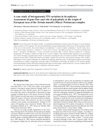Ver ítem
- xmlui.general.dspace_homeCentros e Institutos de InvestigaciónCIRN. Centro de Investigaciones de Recursos NaturalesInstituto de Recursos BiológicosArtículos científicosxmlui.ArtifactBrowser.ItemViewer.trail
- Inicio
- Centros e Institutos de Investigación
- CIRN. Centro de Investigaciones de Recursos Naturales
- Instituto de Recursos Biológicos
- Artículos científicos
- Ver ítem
The phylogenetic relationships of four monospecific caesalpinioids (Leguminosae) endemic to southern South America
Resumen
Balsamocarpon, Lophocarpinia, Stenodrepanum and Zuccagnia are monospecific endemic genera from arid or saline areas of southern South America (Argentina, Paraguay, Chile). Several molecular studies have explored relationships within Caesalpinioideae and the Caesalpinia group but, until now, Stenodrepanum has not been included, Lophocarpinia has been poorly represented and these four South American taxa have not been analyzed together. In order to resolve
[ver mas...]
Balsamocarpon, Lophocarpinia, Stenodrepanum and Zuccagnia are monospecific endemic genera from arid or saline areas of southern South America (Argentina, Paraguay, Chile). Several molecular studies have explored relationships within Caesalpinioideae and the Caesalpinia group but, until now, Stenodrepanum has not been included, Lophocarpinia has been poorly represented and these four South American taxa have not been analyzed together. In order to resolve their evolutionary relationships, a phylogenetic analysis of the plastid trnL–F intron and spacer region that included a broad range of published sequences from Caesalpinieae was used. Combined trnL–F, matK/trnK and morphological data were analysed for a subset of taxa. Stenodrepanum, Balsamocarpon and Zuccagnia formed a monophyletic group with the amphitropical American genus Hoffmannseggia. The clade shares a synapomorphy of sepal persistence in the fruit. Lophocarpinia is shown also to belong to the Caesalpinia informal generic group as traditionally proposed, and grouped with Haematoxylum with which it shares the presence of branches and inflorescences crowded on short shoots and spines derived from branches. As a contribution to the understanding of the Caesalpinia group, phylogenetic hypotheses were used to discuss evolution of selected characters within the group.
[Cerrar]

Autor
Nores, María Jimena;
Simpson, Beryl B.;
Hick, Pascale;
Anton, Ana Maria Ramona;
Fortunato, Renee Hersilia;
Fuente
Taxon 61 (4) : 790-802 (August 2012)
Fecha
2012-08
Editorial
Wiley
ISSN
0040-0262
Formato
pdf
Tipo de documento
artículo
Palabras Claves
Derechos de acceso
Restringido
 Excepto donde se diga explicitamente, este item se publica bajo la siguiente descripción: Creative Commons Attribution-NonCommercial-ShareAlike 2.5 Unported (CC BY-NC-SA 2.5)
Excepto donde se diga explicitamente, este item se publica bajo la siguiente descripción: Creative Commons Attribution-NonCommercial-ShareAlike 2.5 Unported (CC BY-NC-SA 2.5)

